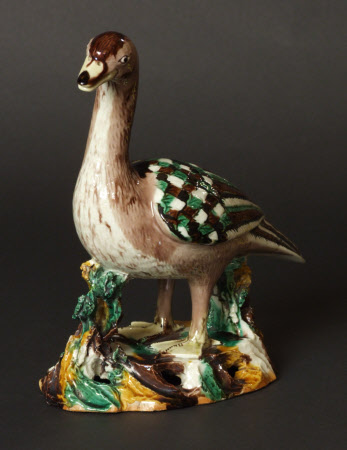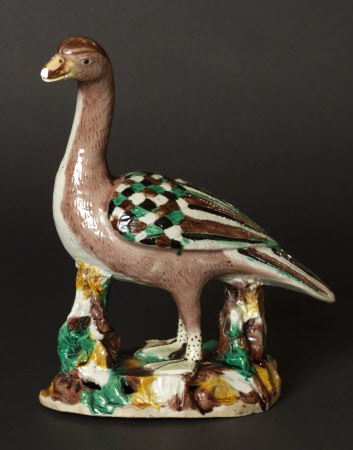Goose
Category
Ceramics
Date
1662 - 1722
Materials
biscuit porcelain
Measurements
235 mm (H)100 mm (W)210 mm (D)
Order this imageCollection
Polesden Lacey, Surrey
NT 1245623
Summary
Pair of figures of geese, hard paste porcelain, the bird standing on the ground among plants, their heads slightly turned, made in Jingdezhen, Jiangxi province, China Kangxi period (1662–1722), c. 1700, decorated on the biscuit (i.e. on the unglazed porcelain) with green, yellow, aubergine and black enamels.
Full description
Although the goose is frequently seen as a motif in the Chinese artistic tradition, signifying peace and marital fidelity, it also appears among the figures made in China for export to Europe, where it was valued primarily as an example of the sophistication of Chinese porcelain-making. The combination of green, yellow and aubergine enamels, sometimes seen on Kangxi-era porcelain, was called sancai (‘three colours’) in China, while in Britain it is sometimes known as the ‘egg and spinach’ palette. A similar pair of figures of geese is in the British Royal Collection, RCIN 58471. For the motif of the goose, see Patricia Bjaaland Welch, Chinese Art: A Guide to Motifs and Visual Imagery, Tokyo, Rutland and Singapore, Tuttle, 2008, pp. 74–5. For the sancai enamel palette, see Rose Kerr and Louisa E. Mengoni, Chinese Export Ceramics, London, V&A Publishing, 2011, pp. 46–7.
Provenance
The bequest of Margaret (Anderson) McEwan, The Hon. Mrs Ronald - later Dame Margaret - Henry Fulke Greville, DBE (1863-1942) from probate records linked with the donation of the property to the National Trust in 1943. These items found on the record for Polesden Lacey Chinese porcelain stored in the Basement, page 86.

